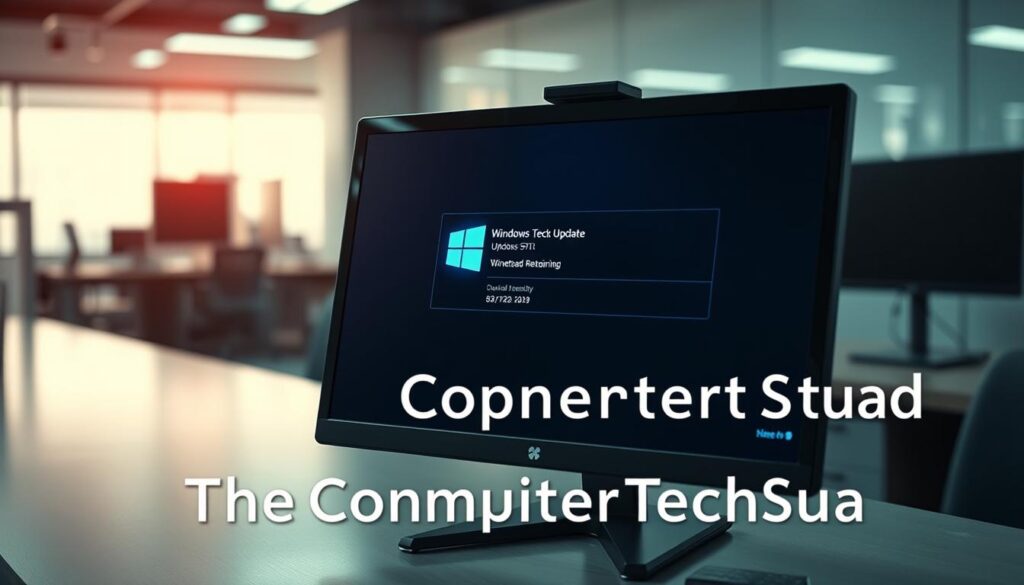Did you know that over 70% of computer users don’t update their systems regularly? This statistic highlights the importance of keeping your computer current with the latest updates. Windows, as a service, continually improves its features and security, ensuring your device stays protected and runs smoothly.
Accessing Windows Update via Settings or using the shortcut is beneficial for early access to new features. As a Windows Insider, you can preview upcoming features and non-security updates, giving you a head start on the latest improvements. Staying informed about update releases helps you leverage enhancements in reliability and performance, maintaining both functionality and security on your device.
Microsoft provides yearly updates and monthly security patches for Windows 10 and Windows 111. Users can configure automatic updates to notify them for download and auto-install rather than automatic installation1. For those who need more control, Windows 10 and 11 Pro, Enterprise, or Education users can defer updates for up to 365 days after their release1.
Regular updates not only improve performance but also address potential security vulnerabilities. By staying updated, you ensure your device remains secure and functions optimally. Whether you’re a casual user or a professional, keeping your system up-to-date is essential for a smooth and safe computing experience.
Introduction to Windows Updates
Windows operates as a continually evolving operating system, designed to adapt to the needs of its users. This evolution is driven by regular updates that enhance both system and device performance. Each release not only introduces new features but also includes critical security fixes to protect your device from vulnerabilities.
One of the key features of Windows updates is the automatic update system. This system simplifies maintenance by automatically downloading and installing updates in the background. Automatic updates ensure your device stays secure and runs smoothly without requiring manual intervention. Additionally, Windows provides detailed update history, which is essential for tracking changes and ensuring system reliability2.
The update process is managed by the Windows Update Client, which operates as a dynamic link library (DLL). This client determines the necessary updates for your device and manages their installation. Understanding the update process helps users appreciate the importance of each release, whether it’s a security patch or a feature enhancement3.
By staying informed about updates, users can leverage the latest improvements in reliability and performance. This ensures their device remains secure and functions optimally, providing a seamless computing experience for everyone.
Understanding New Microsoft Windows Updates
Microsoft Windows updates are essential for maintaining system performance and security. These updates include security patches, bug fixes, and enhancements that improve file handling and app performance. Each update ensures your system stays protected and runs smoothly.
Windows updates are designed for specific versions, such as Windows 10 and Windows 11. Microsoft provides detailed support through update history pages, which list fixes and addressed issues4. This helps users understand the improvements and security measures in each release.
| Update Component | Description | Importance |
|---|---|---|
| Security Patches | Fix vulnerabilities and protect against threats. | Critical for system security. |
| Bug Fixes | Resolve issues and improve stability. | Enhance user experience. |
| Enhancements | Improve file and app performance. | Boost system efficiency. |
Microsoft’s support ensures every fix addresses known issues effectively. Regular updates not only improve performance but also reinforce system security. By staying updated, you maintain the integrity and safety of your system.
How to Check and Install Your Updates
Keeping your system up-to-date is straightforward with Windows Update. To manually check for updates, navigate to Settings > Windows Update. Click on the “Check for updates” button to see if any new releases are available. This process ensures your device receives the latest enhancements and security fixes5.
The update history page provides detailed information about past updates, helping you understand the sequence of releases. This service works continuously in the background, making it easy to stay current without manual intervention6.
| Action | Steps | Benefit |
|---|---|---|
| Manual Check | 1. Open Settings 2. Go to Windows Update 3. Click “Check for updates” |
Ensures you have the latest features and security fixes |
| Review History | 1. Visit Windows Update 2. Click “Update history” |
Tracks installed updates and identifies pending ones |
| Troubleshooting | 1. Use the Windows Update troubleshooter 2. Restart your device |
Resolves common update installation issues |
Regular updates are crucial for maintaining performance and security. If you encounter issues, Microsoft offers helpful resources. Remember, staying updated ensures your device runs smoothly and remains protected against threats.

Exploring New Features and Enhancements
Recent windows updates have introduced exciting features that enhance your device’s health and operating performance. These updates include improvements to file handling, app efficiency, and system stability, ensuring a smoother experience for all users.
| Feature | Description | Importance |
|---|---|---|
| Enhanced Security | Includes advanced threat protection and real-time alerts. | Critical for safeguarding sensitive data. |
| Performance Boost | Optimizes system resources for faster operations. | Improves overall device responsiveness. |
| Streamlined Settings | Offers simplified menus and intuitive controls. | Enhances user experience and accessibility. |
Security updates are vital for protecting against vulnerabilities. They include patches and fixes that address potential threats, ensuring your device remains secure. For instance, the latest updates feature AI-integrated phishing protection and advanced application control, significantly reducing malware risks7.
To review the changes, navigate to the update history page, which lists all recent modifications. Enabling setting for early access allows you to try new features before they’re widely released. This is especially beneficial for users eager to experience the latest enhancements early8.
By staying updated, you not only gain access to new features but also contribute to your device’s overall health and operating efficiency. Early access settings let you explore upcoming features, making your computing experience more efficient and enjoyable.
Troubleshooting Update Installation Issues
Encountering issues during update installations can be frustrating, but there are proven steps to resolve them. Common error codes like 0xc1900223 or 0x80073712 often indicate specific problems, such as failed downloads or missing files9. Understanding these codes is the first step toward fixing the issue.
To diagnose errors, start by checking the update history in Settings. This log provides detailed information about past updates and any errors encountered. For instance, error code 0x800F0923 suggests a driver or software incompatibility9. Sharing this information with peers can help others avoid similar issues.
| Common Issue | Solution | Importance |
|---|---|---|
| Error Codes (e.g., 0xc1900223) | Check update history and online resources for fixes9. | Identifies specific problems for targeted solutions. |
| Installation Stuck | Restart your device or use the Windows Update troubleshooter. | Resolves common installation halts. |
| Driver Incompatibility | Update drivers manually or roll back recent changes. | Ensures hardware compatibility. |
If a new feature is causing problems, consider delaying the update or seeking professional help. Microsoft offers extensive support pages and tools like the Update Health Tools, which can be installed from C:\Program Files\Microsoft Update Health Tools10. Regularly sharing update experiences with others fosters a community that learns and grows together.

Security Benefits and Patch Fixes
Security is a top priority for any computer user, and Windows updates play a crucial role in maintaining it. Each update delivers essential security benefits and patch fixes to protect your device from potential threats. These updates are designed to address vulnerabilities and improve system stability, ensuring your computer runs smoothly and securely.
To start with, patch fixes are critical for mitigating both software issues and emerging security vulnerabilities. For instance, monthly security updates are released on the second Tuesday of each month at 10:00 AM Pacific Time, known as Patch Tuesday11. These updates include fixes for known issues and enhancements that boost system integrity.
It’s important to note that the update history page provides a list of all fixed issues and improvements. This helps users understand the changes and ensures transparency in the update process. For example, if you encountered a driver compatibility issue before an update, the latest patches would directly address and resolve it12.
Regularly installing updates is crucial for maximizing security and performance. By staying updated, you gain access to the latest security features from Microsoft, such as advanced threat protection and real-time alerts. These features are vital for safeguarding sensitive data and ensuring your device remains secure11.
Common issues, such as failed downloads or missing files, are often resolved through these updates. For example, error codes like 0xc1900223 indicate specific problems that patches can fix. Understanding these issues and applying the latest patches ensures your system stays protected and runs efficiently12.
Encourage yourself and others to install updates promptly. Delaying updates can leave your system vulnerable to security threats. By keeping your system up-to-date, you contribute to its overall health and efficiency, ensuring a safe and smooth computing experience for everyone.

Best Practices for Managing Windows Updates
Managing Windows updates effectively ensures your system remains secure and performs optimally. Start by enabling automatic updates to handle downloads and installations without manual intervention. This feature is especially useful for users who want a hands-off approach to system maintenance13.
Periodically check for updates manually to stay informed about the latest releases. Use the Settings > Windows Update section to review update history and pending installations. This helps you stay proactive about system maintenance and security14.
- Select check update options carefully to schedule installations at convenient times, minimizing disruptions to your workflow.
- Monitor update servers to ensure they are functioning correctly and providing the latest patches and features.
- Use resources like Microsoft Edge to access update notes and detailed information about each release15.
For server systems, consider centralized update management tools to streamline the process across multiple devices. This approach ensures consistency and reduces the risk of missing critical updates13.
Stay current with update notifications to avoid missing important information. By following these best practices, you can maintain a secure and efficient system, whether for personal use or managing multiple server environments14.

Conclusion
Staying up-to-date with the latest system updates is crucial for maintaining a secure and efficient operating system. Regular updates not only improve performance and security but also enhance device reliability, ensuring a smooth computing experience for all users.
To ensure your system runs smoothly, follow these simple steps: check for updates via Settings > Windows Update, review your update history, and troubleshoot any issues using Microsoft’s resources. For instance, if you encounter error codes like 0xc1900223, refer to the update history for details and solutions16.
For more information, visit Microsoft’s support pages or access detailed update notes through Microsoft Edge. If you have any questions, the official help channels are readily available to assist you.
Remember, keeping your system updated is key to enjoying a seamless and secure experience. By staying informed and proactive, you ensure your device remains in top shape, ready to handle all your computing needs efficiently.
Source Links
- How to Delay Windows Updates and Tell Microsoft to Leave You Alone
- Introduction to Windows Updates
- Get started with Windows Update
- How Windows Update works
- How to manually check for updates on a Windows 10 computer and install them
- Yes, You Should Install Those Windows Updates! Here’s How
- What’s New with Windows 11 – Compucom
- Delivering continuous innovation in Windows 11
- Get help with Windows upgrade and installation errors
- Guidance for troubleshooting Windows Update issues – Windows Client
- What Is Patch Tuesday and When Is It? – Definition from TechTarget.com
- Update release cycle for Windows clients
- Best practices for software updates – Configuration Manager
- Windows Update for Business
- Prepare a servicing strategy for Windows client updates
- Windows message center


